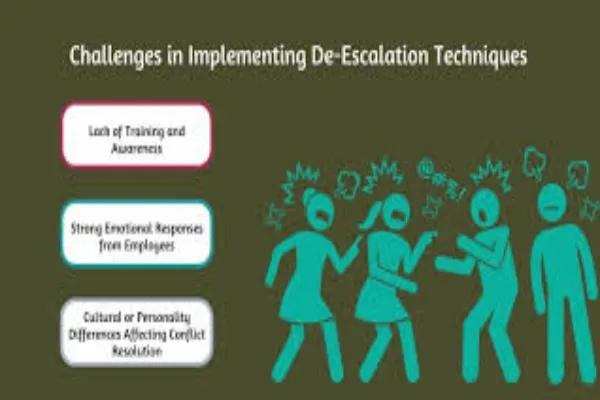Effective Strategies to Enhance Your De-Escalation Training Programs

De-escalation training is essential for managing conflicts and preventing situations from escalating into violence. Effective strategies improve the ability of individuals to remain calm, communicate clearly, and reduce tension, which benefits both safety and outcomes.
Incorporating realistic scenarios, ongoing practice, and feedback mechanisms are key elements to enhance the effectiveness of de-escalation training programs. These approaches ensure learners develop practical skills that can be applied confidently in real situations.
Core Principles of De-Escalation Training
De-escalation training programs must focus on key concepts that improve conflict resolution outcomes. These include understanding conflict dynamics, developing specific skills, and harnessing emotional intelligence to respond effectively.
Understanding the Spectrum of Conflict
Conflict exists on a spectrum ranging from mild disagreement to intense aggression. Recognizing where a situation falls on this spectrum helps tailor responses and prevent escalation.
Trainers emphasize identifying verbal cues, body language, and environmental factors signaling rising tension. For example, raised voices or hostile gestures might indicate the need for immediate intervention.
This understanding allows personnel to choose appropriate de-escalation techniques early, reducing unnecessary confrontation. Awareness of subtle shifts in behavior is vital for maintaining control and safety.
Essential Skills for De-Escalation
Key skills include active listening, clear communication, and maintaining a calm presence. Active listening involves acknowledging concerns without interrupting, showing respect through paraphrasing and eye contact.
Clear communication means using simple, non-threatening language. Avoiding jargon, commands, or confrontational phrases helps maintain openness. Tone of voice should remain steady and calm to reduce tension.
Physical presence matters; non-aggressive posture, controlled gestures, and appropriate personal space signal respect and reduce intimidation. These skills combine to create trust and encourage cooperation.
Role of Emotional Intelligence
Emotional intelligence (EI) enables individuals to manage their own emotions while interpreting others’ feelings accurately. High EI supports patience, empathy, and adaptability during conflicts.
Training focuses on self-awareness to recognize stress reactions and control them. This prevents emotional escalation by the responder.
Empathy allows understanding of underlying issues driving conflict, facilitating personalized responses. Recognizing emotional triggers in others helps avoid actions that could worsen the situation.
Integrating Conflict Resolution Expertise
Effective de-escalation training relies on precise integration of conflict resolution knowledge and practical application. This includes using proven techniques and creating authentic scenarios that reflect real-world challenges.
Incorporating Evidence-Based Techniques
Training programs benefit most when they include evidence-based conflict resolution expertise. These techniques often stem from psychological research and proven communication models like active listening, empathy signaling, and non-verbal de-escalation cues.
Role of active listening: Trainees learn to acknowledge emotions without judgment, which reduces tension and fosters cooperation.
Empathy signaling: Demonstrates understanding of the other party’s perspective, helping to build rapport.
Non-verbal strategies include controlled body language and maintaining appropriate personal space.
Best Practices for Realistic Scenario Development
Scenarios should mimic situations participants are likely to encounter. This means integrating diverse conflict types, environments, and emotional intensities.
Key elements for scenario design:
- Varied conflict contexts: workplace disputes, public disturbances, and interpersonal tensions.
- Role players trained in conflict dynamics to deliver authentic reactions.
- Progressive difficulty: start with simpler conflicts, then increase complexity.
Use structured debriefs after each exercise to analyze behaviors and decision-making.
Including feedback from conflict resolution experts helps ensure scenarios remain relevant and adapt to evolving challenges.
This approach develops practical skills and confidence through hands-on experience in controlled but realistic settings.
Enhancing Engagement and Retention

Engaging participants actively and ensuring they retain skills is critical in de-escalation training. Practical methods, individualized support, and addressing common obstacles all contribute to more effective learning outcomes.
Interactive Learning Methods
Interactive learning keeps trainees mentally and physically involved. Role-playing exercises that simulate real-life scenarios allow participants to practice de-escalation techniques safely and build confidence.
Using multimedia tools like videos and virtual reality can demonstrate body language and tone, reinforcing key concepts. Group discussions encourage sharing diverse experiences, which deepens understanding and application.
Employing quizzes or gamified elements keeps attention while measuring ongoing comprehension. These varied methods accommodate different learning styles, improving both engagement and long-term retention in de-escalation training.
Personalized Feedback and Coaching
Tailored feedback identifies strengths and areas for improvement in each participant. Instructors should observe practice sessions and provide specific guidance on communication skills, emotional control, and tactics.
Coaching sessions that follow training help reinforce skills through individual or small group meetings. This ongoing support addresses personal challenges and encourages gradual improvement.
Personalized feedback builds accountability and motivation. It helps participants refine methods that work best for them, leading to higher proficiency in real-world de-escalation situations.
Overcoming Training Barriers
Common barriers include resistance to training, time constraints, and varying experience levels among participants. To address resistance, trainers must clarify the relevance of de-escalation skills to participants’ roles and safety.
Flexible scheduling and modular training formats accommodate busy workloads. Breaking sessions into shorter, focused segments reduces fatigue and increases attentiveness.
Adapting content to different skill levels ensures everyone benefits, from novices to experienced personnel. Clear communication, supportive environments, and accessible resources help minimize these barriers effectively.
Measuring Effectiveness and Continuous Improvement
Tracking specific outcomes and adjusting training protocols ensures de-escalation training remains relevant and impactful. Evidence-based evaluation helps identify strengths and weaknesses in training delivery and participant comprehension.
Key Performance Indicators
Organizations should measure metrics that directly reflect the success of de-escalation efforts. Key indicators include the frequency of incidents requiring intervention, participant confidence scores before and after training, and the reduction in use-of-force occurrences.
Collecting data through surveys, incident reports, and scenario assessments provides quantitative and qualitative insights. Tracking response times and communication effectiveness during simulated exercises also informs program performance.
Adapting Programs Based on Results
Analysis of performance data should drive curriculum adjustments and training methods. If participants struggle with specific scenarios like verbal de-escalation, modules can be revised to include more practice or expert coaching.
Feedback from trainees and trainers adds context to numerical data, highlighting obstacles or misunderstandings. Incorporating this feedback fosters a responsive training environment.
Adapting programs includes updating content to reflect changes in policy or emerging best practices. Continuous iteration based on measurable results ensures that de-escalation training remains effective and applicable in real-world situations.




